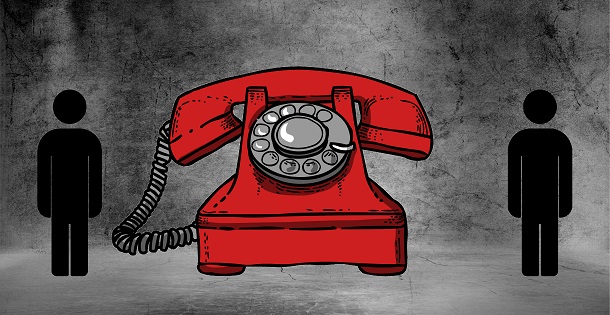For the better part of the life of the telephone — more than 100 years — a phone call was an event. The jarring ring would set a household in motion to discover what the mysterious caller had to say.
The family phone had its own table to rest upon, and a pen and notepad waited nearby in case someone needed to take an important message. If you missed the call, you were missing out.
Today, we might be missing out more than ever.
The flat devices we now carry around like life support can hardly be called phones anymore. Since 2007, Americans have been texting more than calling, and in 2015 an Informate report found that we send more than five times as many text messages as phone calls. Some recent reports even claim that 40 percent of 18-24 year-olds are anxious about speaking on the phone. Smartphone users — particularly younger ones — are communicating more overall, but the trend of typing it out is killing some crucial aspects of conversation.
The proclivity to text instead of call is about control, according to Ken Sereno, an expert in interpersonal communication at University of Southern California. “When you use text or e-mail, you have a chance to compose yourself before you respond, and you can carefully choose the words you say,” Sereno says. While it may be a comfort to present a polished version of oneself in lieu of the awkward and messy affair of “going live,” Sereno says text messaging leaves out some important aspects of conversation like vocal intonation, rate of speech, and pauses: “You can only make a judgement based upon your own interpretation of the text, and those are made based on past experiences.”
If someone responds to your knee-slapper text with “lol,” they might be lying, but you know they understood your punchline. You probably have experience with the “laughing out loud” abbreviation, even if you’re unfamiliar with the more esoteric diminutives, “lolz” and “I’m dying [laughing].” But you’re still not experiencing their reaction. The rich connection of a shared chuckle is lost, along with the inevitable risk of your quip landing flat.
This is all to say that text communication is… boring. And formulaic.
MIT professor Sherry Turkle studied the communication habits of each generation for her book Reclaiming Conversation: The Power of Talk in a Digital Age, and she notes that the aversion to real-time talking is intergenerational. The Guggenheim fellow explains, “The anxiety about spontaneity and the desire to manage our time means that certain conversations tend to fall away.” Namely, the ones in which we discover something unexpected about each other. An instant message-based relationship — unsurprisingly — delivers the lowest amount of emotional connection while giving users the illusion of it, or at least the absence of loneliness.
Turkle follows the phone phobia of 2008 and ’09 high school graduates into their post-college careers, where phone conversations and personal connections are often a necessary undertaking. The millennial group finds dialing others to be “exhausting and, whenever possible, something to avoid,” and “very few will use the phone unless specifically instructed to do so.”
Worse yet, the calls that are being dialed are coming from robot salespeople and scammers. If you had a feeling that “Rachel from cardholder services” is calling more than ever lately, you aren’t imagining things. Last month, the number of robocalls was at an all-time high — more than quadruple the numbers from fall of 2015. It’s no wonder that no one wants to pick up.
The phone call appears to be in danger of becoming a bygone oddity if current trends keep up. The implications for romance, family, and the workplace could be severe and lasting.
We have another, perhaps better, option, though, and it’s been gaining traction for years: video calling. In a Cyberpsychology study of 58 female college students, video calling was found to be only slightly less personal than in-person conversation, as measured by empirical signals of bonding like affirmative nods, leaning in, and the Duchenne smile: “Video chat, which affords the ability to exchange both verbal and visual cues, more closely resembled in-person communication in terms of bonding than it did [instant messaging].”
To date, the feature hasn’t yet prompted a cottage industry of anxiety-induced masks and prostheses as David Foster Wallace satirically predicted in Infinite Jest, but video calling is taking off. Just this year, Snapchat and Instagram — two wildly popular apps among Millennials and Generation Z — have added video chat options. Along with Skype, FaceTime, Messenger, WhatsApp, and Zoom, that makes for a host of options for video calls that can include up to 50 participants.
“People use live video to just hang out,” Facebook founder and CEO Mark Zuckerberg said at the company’s annual conference in May. “Hanging out” seems far less stressful than “having a conversation,” particularly if a handful of people are on the line. Teens use group video chatting more often than adults, and they use it for everything from homework to gossip. While it may trigger the anxiety of real-time communication, the presence of several other friends can make a call seem more casual. Also, teenagers value privacy, and a video call cannot likely be accessed later on by parents like a text message can.
The future of communication won’t likely resemble any romantic notion we have of the past, but that doesn’t mean we shouldn’t take the time to evaluate the outcomes of our new conversational spaces. Rapid advancement can make that a difficult task. The value of meaningful personal connection should be the focus of any communication technology, and, since it’s a natural human inclination, perhaps a balance can arrive organically. Then again, synthetic telepathy could be just around the corner.
Become a Saturday Evening Post member and enjoy unlimited access. Subscribe now




Comments
It’s interesting how THIS feature ties in with the ending of this week’s chapter (58) of the Post’s weekly online feature ‘North Country Girl’ by Gay Haubner. In it, a friend advises her to call a man connected with Esquire magazine regarding a possible job there. She calls, gets him on the phone, and after a brief discussion says “Come up tomorrow at eleven.”
This was in 1977. Such a simple exchange today would be SOOOO far-fetched as to be virtually impossible. The bottom line and irony of all of today’s ever advancing communication technology is that it’s a great time to BE technology and not a person. The fact we’re so overly aware of technology all of the time (and its awareness of us), has short-circuited millions of Americans out, Nicholas. They now need to be in a marijuana haze to deal (or not deal?) with the nightmare of life today and/or TRY to feel ‘normal’.
One big beneficiary of all the overly complexity are dogs (and cats) but particularly dogs. They’re more loved, appreciated and important than ever before. This has been a wonderful development, but it’s also a byproduct of tech overload and not being able to trust people. Dogs are filling the need for humanity that’s gone now from most people, elevating their status in society. Many people prefer the company of dogs over people, but not always.
I attended a basset hound wedding recently that was fantastic. It was all ‘dog people’, including a real nun that performed the ceremony and the only talk of technology was how these dogs are such a wonderful simple, loving antidote to people! Each dog got a small slice of the vanilla (3 tiered) wedding cake with that whipped vanilla frosting they—gobbled down.
Not to offend anyone, it was NOT disrespectful of Catholics, the Catholic church or the sanctity of marriage! The bride and groom will live with their respective parents at their respective homes but will have play dates as schedules allow. In Ca., Mom & Dad have to work full-time + additional ‘gigs’ just to keep their heads above water, which doesn’t allow for much leisure time. Dogs are the perfect ‘children’ for today’s world. Thank you God!